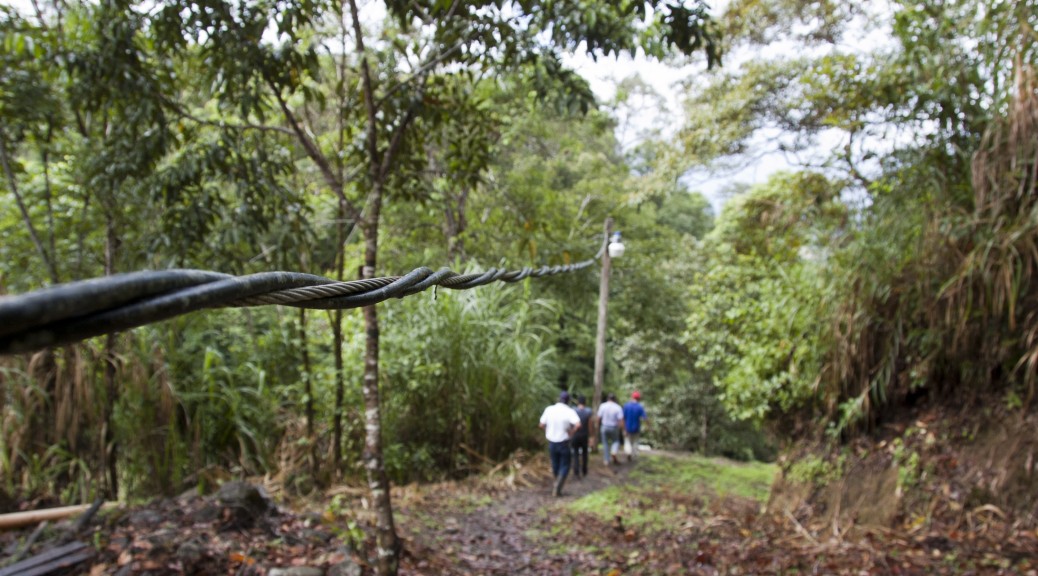On a dirt road high in Nicaragua’s northern mountains, a small knot of men and two precocious young boys uncoil electrical cable from the back of a pickup truck. Other workers swing machetes at overhanging tree branches. Along the cleared shoulder of the road, another crew tightens a cable on a freshly planted utility pole.
Verdant coffee plantations line the steep road, punctuated by wooden shacks where pigs orbit stakes in the mud. Placards on outhouses proclaim the names of aid organizations. Cinder-block evangelical churches mark even the tiniest clusters of homes.
This extension of the power grid will serve about 30 families in the San Ramón valley, about 200 kilometers northeast of Managua. “We’ve always lived in the dark here,” says Salvador Gonzáles, a resident of the valley and one of the men volunteering on the line crew. For him, the arrival of electricity means a refrigerator and a leap in quality of life. “I’ll have my soda cold, some chicken, some meat, a Popsicle,” he says.
Rural electrification swept through the Western Hemisphere decades ago, but Nicaragua missed out: Electricity reaches barely a third of rural Nicaraguans like Gonzáles. The country’s overall electrification rate of around 74 percent puts it ahead of Haiti and behind every other country in the hemisphere.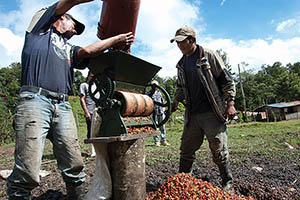
There is no physical reason for this impoverishment. Nicaragua is wet, windy, mountainous, volcanic, and tropical, meaning it is an excellent candidate for hydroelectric, wind, geothermal, and solar power. Estimates of its geothermal potential alone have put the figure at several thousand megawatts [PDF]; for reference, the country’s entire installed capacity is about 1,410 megawatts.
In recent years, investments in renewable energy projects have soared, thanks to generous tax breaks. But imported oil still accounts for half of the country’s electricity generation.
The government in Managua, under the idiosyncratic rule of Daniel Ortega, the Sandinista who also led the country in the 1980s, has a plan to raise the electrification rate to 85 percent by 2016. But Nicaraguans in and around the San Ramón valley are tired of waiting. With the help of a local nonprofit group, the inhabitants are taking the electrification of their homes into their own hands. The electricity that Gonzáles will soon enjoy comes from a small hydroelectric plant in the nearby town of El Cuá. And that plant is part of a rich legacy that encompasses a small act of war, some stubborn and idealistic engineers, and a rare unity among fierce, independent people.
It’s hard to picture now, but 30 years ago Nicaragua was an international hotbed of revolution and a Cold War proxy battleground between the United States and the Soviet Union. Many Nicaraguans sympathized with the socialist Sandinista National Liberation Front, which came to power in 1979 after toppling the U.S.-backed Somoza family. These tropical northern highlands saw some of the heaviest fighting between U.S.-backed contra guerrillas and Nicaraguan forces. Over the course of the decadelong war, tens of thousands of Nicaraguans died.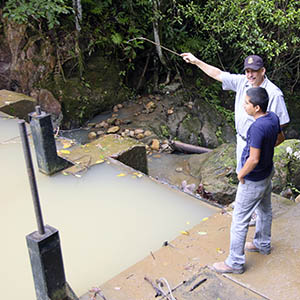
At the edge of the regional capital of Matagalpa, a road leads to the modest administrative office of the Association of Rural Development Workers—Benjamin Linder (known by its Spanish acronym, ATDER-BL). Benjamin Linder was a young American engineer who sympathized with the Sandinista movement and came to Nicaragua in 1983 to work on engineering projects. The first project he completed was a 100-kilowatt hydroelectric plant near El Cuá.
Hardworking, idealistic, and playful, Linder entertained the locals by riding his unicycle through town while juggling, sometimes dressed as a clown. At the time, El Cuá was a town of 2,000 that lacked electricity, running water, and sanitation. Despite the logistical challenges of operating in a war zone—contra guerrillas mined the road to El Cuá and sprang frequent ambushes—Linder supervised the completion of the El Cuá plant in 1985 and soon began work on another.
Then, on 28 April 1987, contra soldiers attacked and killed Linder and two Nicaraguans named Sergio Hernández and Pablo Rosales as they worked at the site of the new plant near the town of San José de Bocay. Linder, the only American civilian to be killed by the contras, was 27 years old. In 1988, the IEEE Society on Social Implications of Technology posthumously awarded Linder the Carl Barus Award for Outstanding Service in the Public Interest, in recognition of his “courageous and altruistic efforts to create human good by applying his technical abilities.”
Other hands took up Linder’s work. Shortly after he died, his family and friends began raising funds to complete the plant, and Bocay residents volunteered their labor. A colleague of Linder’s named Rebecca Leaf was working at the time for the Nicaraguan Energy Institute in Managua. The MIT-educated engineer gave up her government job to lead the design and construction of the Bocay plant.
At times, progress ground to a halt, hampered by a U.S. trade embargo that limited the availability of parts. Even after the 1990 peace settlements, guerrilla groups continued to threaten the area. Still, Leaf and her team completed the 185-kW hydroelectric plant in 1994, and today the turbines in Bocay and El Cuá continue to generate electricity.
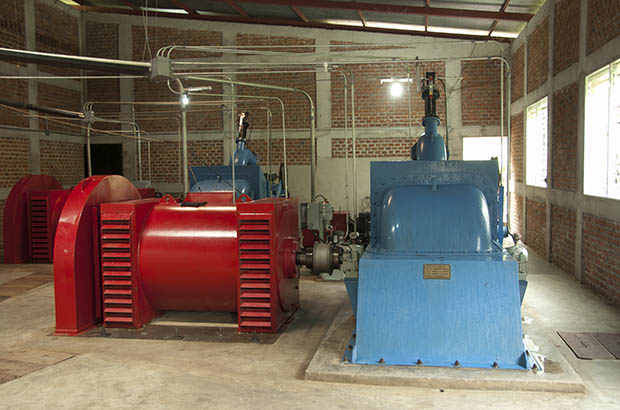 And 21 years later, Leaf is still here. These days, she is the director of ATDER-BL, which she founded after Linder’s death, and she lives in El Cuá, working from the group’s operations office here. Sunlight bathes the blue one-story building, which is set behind a chain-link fence just off the town’s only paved road. Flocks of birds in nearby trees twitter and shriek, and a metallic screech rings out from the adjacent machine shop, one of the first buildings to get electricity. Visitors wander in, clutching electric bills.
And 21 years later, Leaf is still here. These days, she is the director of ATDER-BL, which she founded after Linder’s death, and she lives in El Cuá, working from the group’s operations office here. Sunlight bathes the blue one-story building, which is set behind a chain-link fence just off the town’s only paved road. Flocks of birds in nearby trees twitter and shriek, and a metallic screech rings out from the adjacent machine shop, one of the first buildings to get electricity. Visitors wander in, clutching electric bills.
Leaf emerges from her office with an armful of maps and spreadsheets that document the association’s work. She speaks quietly despite the din. The Bocay project “left us with partially trained machinists, welders, masons, surveying crew, pipeline installation experts, and electricians,” she recalls. The workers could have returned to their day jobs—farming, cutting hair, maintaining the town’s fleet of Soviet jeeps and American school buses. Leaf, too, could have found work elsewhere.
But people from nearby communities “came looking for us, saying that they had a river and they wanted to have a hydro plant, too,” she explains. And so she began canvassing international donors for funding. The money was there—but for drinking water systems, not hydroelectric plants. And so for several years, the team switched to constructing potable water systems, the basic piping of which wasn’t too different from that of the hydropower plants they’d been building. “That was our bread-and-butter income,” Leaf says.
As word of ATDER-BL’s work spread, the group returned to building hydropower plants, ranging in size from pico-plants that generate just enough juice to charge a car battery and light a school, to microplants of 3 to 8 kW that local farmers can operate themselves, to one plant that’s nearly a megawatt and now powers about 4,000 homes. In total the group, which now has a full-time staff of 40, has installed about 30 small hydroelectric plants throughout the region. It has consulted for Nicaragua’s Ministry of Mines and Energy and the United Nations Development Programme on dozens more.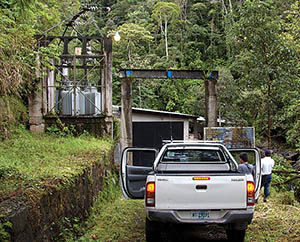
“ATDER-BL’s work has improved the quality of life for thousands of Nicaraguans, from schoolchildren to farmers, with the support and help of local communities,” says Laurie Guevara-Stone of the Rocky Mountain Institute, in Snowmass, Colo., who has worked on renewable energy in Nicaragua and other Central American countries. “Their approach could really serve as a model for rural electrification in other parts of the world.”
Despite its international reputation, ATDER-BL has never lost its local focus. Just as the group had done in El Cuá and Bocay, it still leans heavily on local workers for the construction of each new hydroelectric plant, explains electrical engineer Abner Talen. The association asks each household to provide a volunteer to do the less technical work: branch clearing, pole hoisting, cable laying, concrete pouring. ATDER-BL’s crew does the rest.
“The people have to be willing to work,” Talen says. “They have to take on the project as their own.” Countless other well-meaning development efforts don’t follow that approach—and they fail, he adds. “There are lots of experiences where the population was given everything and then they don’t take care of it like they should.”
One of the smallest of ATDER-BL’s hydropower plants is a 2-kW system owned and operated by a coffee grower named Martín Rivera and his neighbors. His house is nestled on a lush slope surrounded by bushes heavy with red, ripening coffee berries. Several years ago ATDER-BL advised him and his neighbors when they installed their plant. Now the generator hums in a closet-size shed downhill from Rivera’s farm. Upstream, a tiny dam hidden in the thick forest captures the water to drive the small Pelton wheel turbine.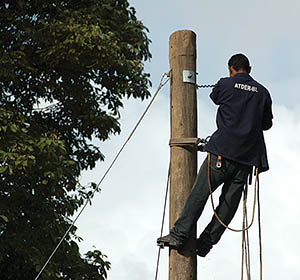
Twenty years ago, Rivera would have never worked with a group like ATDER-BL. He fought on the side of the contras, and during the worst of the fighting, he sent his son Álvaro to the lowlands to study. When the war ended, Rivera returned to farming. And his son, who’d gotten an agricultural engineering degree, came home and began working for ATDER-BL.
Microhydroelectric systems like Rivera’s run at full capacity only when there’s enough rain. At drier times, they generate less power or none at all. But the bigger, newer sites need to operate continuously and sell their excess power to the grid to recoup their up-front cost, says Leaf. The cost of raw materials like copper has soared, and the increasing automation of the plants’ control systems, which rely on more expensive components and software, has also driven up costs.
Ensuring a steady supply of water for its hydropower plants has been a challenge for ATDER-BL, and it has pushed its engineers into an unexpected new sideline: watershed conservation. In this regard, the association’s biggest project to date, located at the foot of a steep rocky stream near the tiny town of El Bote, presented a thorny challenge.
The 930-kW plant was completed in 2008 and financed in part with a US $1.3 million loan from the World Bank and $400,000 from the nonprofit Green Empowerment, based in Portland, Ore. (Green Empowerment, founded by friends and neighbors of Ben Linder’s family, has provided ATDER-BL with technical, organizational, and financial assistance since 1997.) The El Bote plant now generates about 5.8 gigawatt-hours per year, enough to power around 6,000 homes in the region. And the local community is thriving. “El Bote is a town of only 95 houses,” Leaf says, “but as soon as there was electricity available, they started increasing the years of schooling…and they graduated the first class of high school students about three years ago.”
But even as construction of the power plant got under way in 2002, the surrounding area was rapidly changing—for the worse. On Leaf’s first visit to the Bosawás Biosphere Reserve, northeast of El Bote, she recalls, “It looked like a place for a Tarzan movie, with vines dangling down from the trees along the side of the river and flocks of red parrots flying overhead, the monkeys calling from the trees nearby, throwing things at you.” But at the forest’s edges, she says, “we saw the virgin forest smoldering. It was the slash and burn of poor people needing to establish agriculture.”
Such wholesale land clearing is bad for hydroelectricity. Fields of corn and beans, which the poorest farmers plant because they offer a quick return on investment, are prone to soil erosion. During the rainy season, the sediment washes from deforested farmland, clogs streams, disrupts dams, and hobbles the hydropower generators. And without the shade of trees overhead, streambeds dry up.
Someone had to ensure the region has enough water to feed its hydropower plants, and that person turned out to be Boanerge Rocha Moreno. The agricultural engineer stands at the intersection of two dirt roads, where one-room wooden houses sport rooftop satellite dishes. He wears a Boston Red Sox cap, a spotless white polo shirt, jeans, and rubber boots.
“When I came for the first time to El Bote, this was naked earth. There were no trees,” he says, as he hops into the association’s shiny new Toyota Hilux. The truck dodges puddles and fords streams, and Rocha points to the roadside, which has been planted with a yellow-green grass that helps hold the soil. Growing coffee also helps, he says. Although it takes longer to mature than corn or beans, coffee can grow in the shade of trees that better protect the watershed’s soil. And because coffee sells at higher prices, growers can afford to leave forested patches on their land. ATDER-BL has bought about 800 hectares of forest upstream from the El Bote and Bocay plants and has overseen the planting of thousands of trees.
“We try to inform people that we have to take care of the forest, that the water depends on the forest, and that water is life,” Rocha says.
That message is trickling down to the farmers, who have embraced it with varying degrees of enthusiasm. One of the more passionate is Luís Euxebio Irías Calderón. He farms in a valley so steep that horses move faster than motor vehicles, and he is also the part-time operator of a nearby microhydropower plant. Irías’s smile gleams gold as he offers to sing a song he composed for the plant’s recent inauguration in the Valley of the Olivas.
“The song is kind of raw since we don’t have a guitar,” Irías says, before belting out the ballad: “The engineer Rosales / Hatched the plan / To bring the project / To the Valley of the Olivas.” Midway through, he gets to “Got to plant trees / All over the range / So that tomorrow / We aren’t unprepared.”
The engineer in Irías’s song is Félix Rosales, ATDER-BL’s energetic young project manager and Leaf’s protégé. Standing nearby, Rosales smiles as Irías croons. A graduate of the National University of Engineering in Managua, Rosales talks of the powerful ripples that emanate from electrification projects: The availability of electricity draws skilled workers to the region—high school teachers, doctors, merchants, all of whom have the disposable income to pay more for goods and services.
That is what happened in the mountain towns that ATDER-BL has helped electrify. No longer places from which parents send their children away, these towns are growing, and the people, having endured years of deprivation and violence, are hopeful.
But there is still work to do, Leaf says. Interconnecting El Cuá’s regional power grid to the national grid has posed technical challenges. “The nearest point for the intertie was a decrepit rural circuit of Nicaragua’s northern utility, Disnorte, with patched conductor wires and fissured porcelain insulators,” Leaf says. The line’s unreliable voltage frequently forces the hydro plants’ generators to trip off-line, damaging the generators’ main circuit breakers and the transformers’ power interrupters. At its own expense, ATDER-BL installed a supervisory control and data acquisition (SCADA) system to help manage the problem and get the plants back on line faster after each trip event.
“For Disnorte, it’s just another low-income rural circuit,” says Leaf. “For us, it’s fundamental to everything that we’re doing.”
Meanwhile, in San José de Bocay, the population has been growing by about 8 percent a year. “There’s a big demand for electrical service and basic services,” says José Luís Olivas Flores, whom Leaf recruited to lead Aprodelbo, a nonprofit there that operates the plant and the local grid. “Now we have cellphones, cybercafés, cable TV. We could say the window has opened to the world due to having electricity.” The 185-kW hydro plant that ATDER-BL completed in 1994 can no longer supply the 1,500 homes, farms, small businesses, schools, churches, gas stations, and municipal government office. Now there’s talk of building an 820-kW hydroelectric plant, he says.
ATDER-BL must also contend with federal electricity regulations that allow Disnorte to charge the association retail rates for its electricity but to buy electricity from ATDER-BL at the lower wholesale rates. Nicaragua is in the process of reforming its renewable energy laws, and Leaf and her team are lobbying legislators for a more equitable arrangement.
Leaf may speak softly, but she has helped an entire region to speak for itself. And to sing. Irías laughs as he reaches the end of his song: “And with this I’ll leave / Forgive the bad singing / Got to take care of the project / Which has cost us so much.”
This feature first appeared in IEEE Spectrum Magazine in May 2015: [html] [pdf].
See and hear also the accompanying radio feature for IEEE Spectrum’s partner show, NPR’s Here & Now: [html] [mp3].
